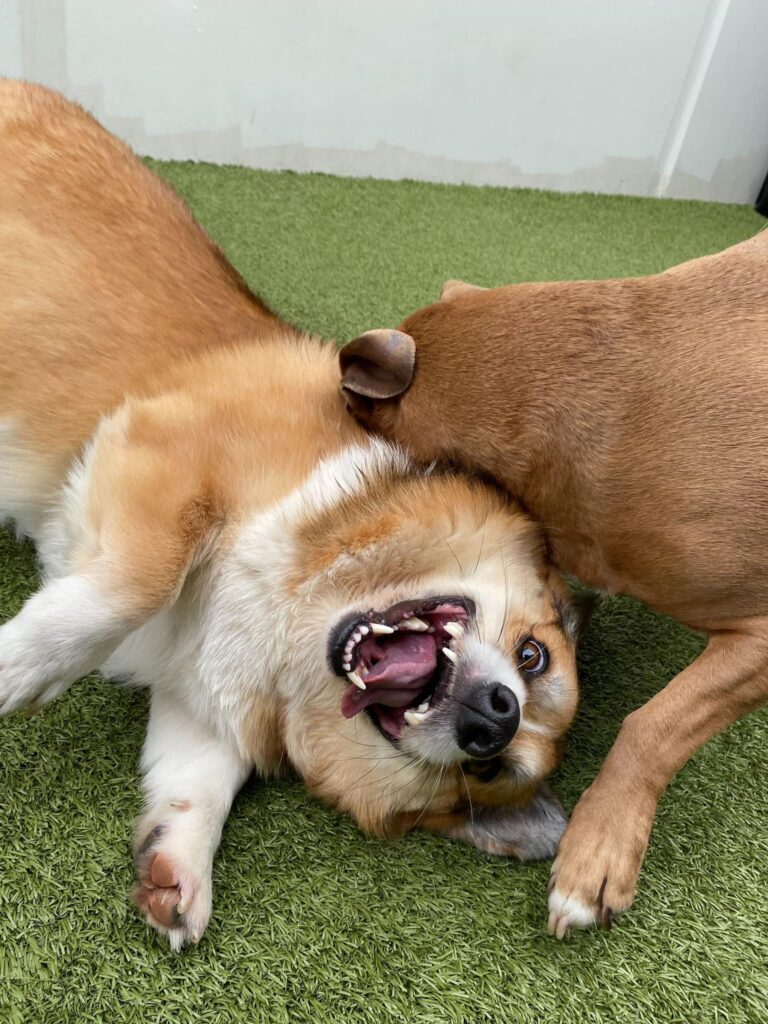Did you know that dogs are master communicators? Dogs use a variety of motions, stances, and physical signals to demonstrate how they are feeling within their environment. Some physical cues are common and seen often, such as a tail tucked between the legs. However, people typically are not familiar with the more subtle signs of canine body language. Often, even the physical cues that most people are familiar with are misinterpreted - like a wagging tail. People often assume that a wagging tail means a dog is happy, but the position of the tail base, the rhythm, and speed of the wagging tail tell us much more!
When learning about canine behavior and body language, it can be easier to first look at each part of the dog's body separately before you start putting the pieces together. A dog's eyes, ears, mouth, facial expressions, overall body posture, tail, and the context of the current environment and situation all need to be taken into consideration in order to better understand their current emotional state.

Facial Expressions
Facial expressions include a dog's ears, eyes, and mouth. The positioning of their ears, for example, will help determine if the dog is aroused or on alert. Typically, erect, forward facing ears indicate arousal or that the dog is interested in something in the environment, while ears that are down and back against the head position may indicate fear. "Neutral" ears (in normal position - not facing forward or flat back) help indicate that the dog is relaxed.
The whites of a dog's eyes usually do not naturally show. If the whites of the eyes are showing, this is a signal that the dog is feeling unsettled. The same can be said if the dog is glancing away from something, or the dog's brow is furrowed. Dogs that display a long, hard stare may be threatening another dog or person - in this case it's important that you do not approach the dog. A soft gaze, relaxed eyelids, or a slight squint may indicate that a dog is feeling relaxed and calm.
It's also important to pay attention to a dog's mouth! An open, relaxed mouth and light panting (tongue may be hanging out of the side of the mouth) typically indicate a dog is happy; however, a wide, tight mouth with excessive panting (may be foam from the tongue movement) is a sign of stress. Constant nose or lip licking and exaggerated yawning also indicate stress. A tightly closed mouth may mean the dog is feeling unsettled and a snarl is a sure threat. These facial expressions are always accompanied by many other physical cues - and you have to put them all together to get a good idea of how the dog is doing.

Posture
Overall body posture can tell us a lot about how the dog is feeling. First and foremost, raised hackles, or hair raised on their back, also known as piloerection, is an indicator that the dog is aroused, but alone it does not mean that the dog is aggressive. Raised hackles, or piloerection, is natural for a dog and similar to goosebumps for humans - they have no control over it!
A crouched or hunched posture will indicate stress and fear. You will often see this posture paired with a tucked tail and flattened back ears. If you look closely, the dog's body weight is likely shifted backward. This dog is probably trying to make themself appear smaller because they are feeling threatened in some way.
A dog laying on their back may want belly rubs, but may also be exhibiting "submissive" behavior to indicate that they are not a threat (example: a dog or stranger comes up to your dog and they immediately roll over and show their belly). If the latter is the case, you may also see lip licking and other signs of stress.
If the dog is standing tall with their head up, tail up, and weight shifted forward, then they might be feeling a little too confident. This dog could be more likely to threaten other dogs during greetings and play. If a dog appears stiff overall, it is important that you do not approach for your own safety.

Overall, we want to see neutral body posture with a relaxed mouth, soft eyes, and loosley wagging tail. However, dogs are always communicating with each other, the environment, and us. On a regular basis you will see some of the other signals discussed in this article. Context will have a lot to do with this! Your dog may appear more alert on walks or when they see a squirrel. They might display more stress signals or signs of fear when going to new places. Either way, it's important to understand and acknowledge how your dog is feeling. The earlier you are able to pick up on signs of discomfort, the more quickly you can work to reduce them and the safer you can keep everyone!

Knowing canine behavior and body language is essential to a dog's overall health and happiness. Visit Biscuits Doggie Daycare and Pet Resort to schedule a behavior consultation to better understand your dog's body language and their meanings. Biscuits Doggie Daycare provides a team of qualified and dedicated dog trainers that will work your dog through one-on-one training, puppy preschool, puppy kindergarten, and day training.



